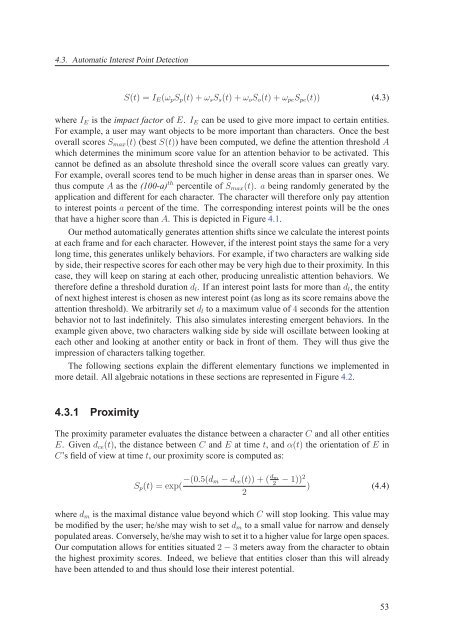Texte intégral / Full text (pdf, 20 MiB) - Infoscience - EPFL
Texte intégral / Full text (pdf, 20 MiB) - Infoscience - EPFL
Texte intégral / Full text (pdf, 20 MiB) - Infoscience - EPFL
Create successful ePaper yourself
Turn your PDF publications into a flip-book with our unique Google optimized e-Paper software.
4.3. Automatic Interest Point Detection<br />
S(t) =IE(ωpSp(t)+ωsSs(t)+ωoSo(t)+ωpeSpe(t)) (4.3)<br />
where IE is the impact factor of E. IE can be used to give more impact to certain entities.<br />
For example, a user may want objects to be more important than characters. Once the best<br />
overall scores Smax(t) (best S(t)) have been computed, we define the attention threshold A<br />
which determines the minimum score value for an attention behavior to be activated. This<br />
cannot be defined as an absolute threshold since the overall score values can greatly vary.<br />
For example, overall scores tend to be much higher in dense areas than in sparser ones. We<br />
thus compute A as the (100-a) th percentile of Smax(t). a being randomly generated by the<br />
application and different for each character. The character will therefore only pay attention<br />
to interest points a percent of the time. The corresponding interest points will be the ones<br />
that have a higher score than A. This is depicted in Figure 4.1.<br />
Our method automatically generates attention shifts since we calculate the interest points<br />
at each frame and for each character. However, if the interest point stays the same for a very<br />
long time, this generates unlikely behaviors. For example, if two characters are walking side<br />
by side, their respective scores for each other may be very high due to their proximity. In this<br />
case, they will keep on staring at each other, producing unrealistic attention behaviors. We<br />
therefore define a threshold duration dl. If an interest point lasts for more than dl, the entity<br />
of next highest interest is chosen as new interest point (as long as its score remains above the<br />
attention threshold). We arbitrarily set dl to a maximum value of 4 seconds for the attention<br />
behavior not to last indefinitely. This also simulates interesting emergent behaviors. In the<br />
example given above, two characters walking side by side will oscillate between looking at<br />
each other and looking at another entity or back in front of them. They will thus give the<br />
impression of characters talking together.<br />
The following sections explain the different elementary functions we implemented in<br />
more detail. All algebraic notations in these sections are represented in Figure 4.2.<br />
4.3.1 Proximity<br />
The proximity parameter evaluates the distance between a character C and all other entities<br />
E. Givendce(t), the distance between C and E at time t, and α(t) the orientation of E in<br />
C’s field of view at time t, our proximity score is computed as:<br />
Sp(t) =exp( −(0.5(dm − dce(t)) + ( dm<br />
2<br />
2<br />
− 1))2<br />
) (4.4)<br />
where dm is the maximal distance value beyond which C will stop looking. This value may<br />
be modified by the user; he/she may wish to set dm to a small value for narrow and densely<br />
populated areas. Conversely, he/she may wish to set it to a higher value for large open spaces.<br />
Our computation allows for entities situated 2 − 3 meters away from the character to obtain<br />
the highest proximity scores. Indeed, we believe that entities closer than this will already<br />
have been attended to and thus should lose their interest potential.<br />
53

















